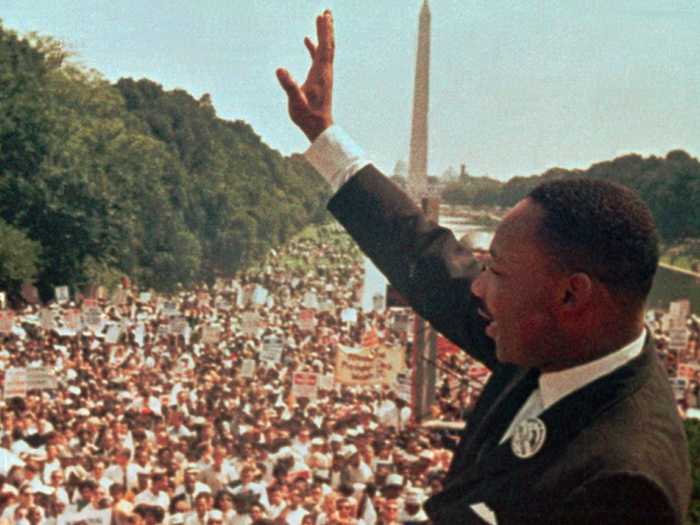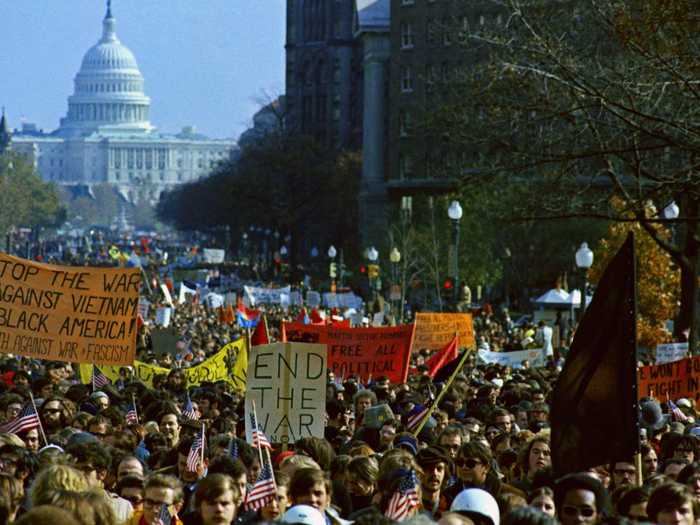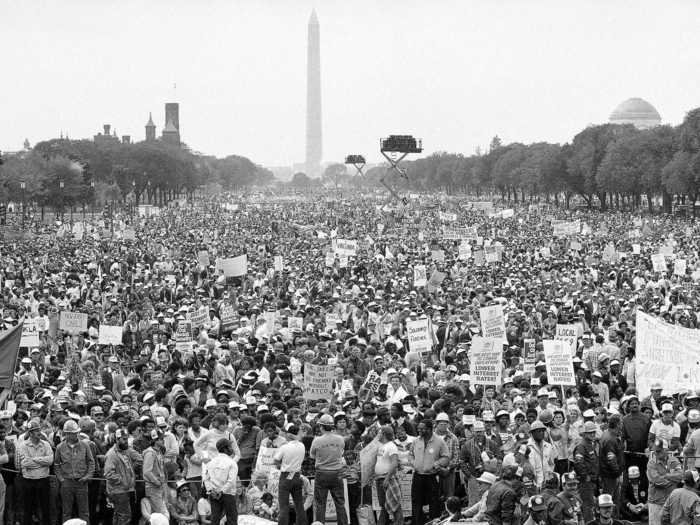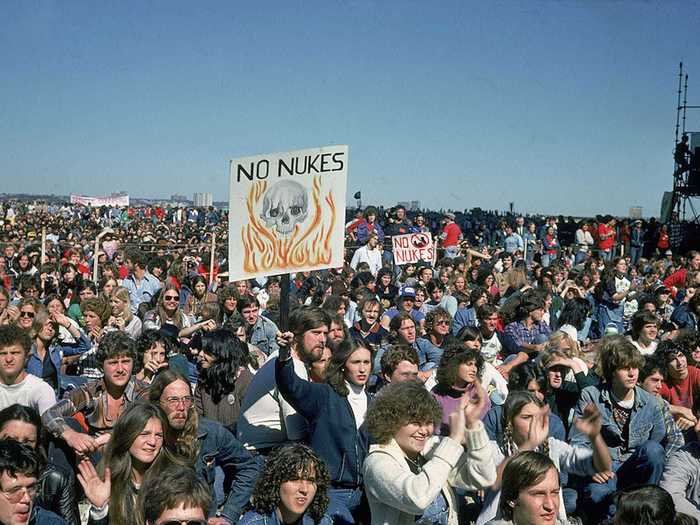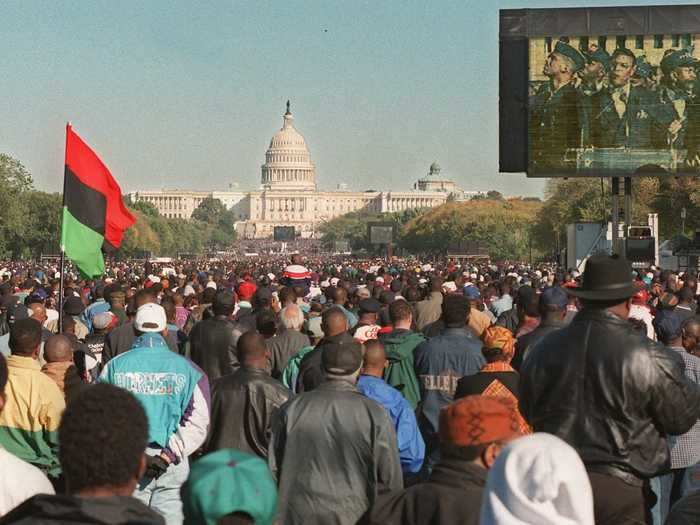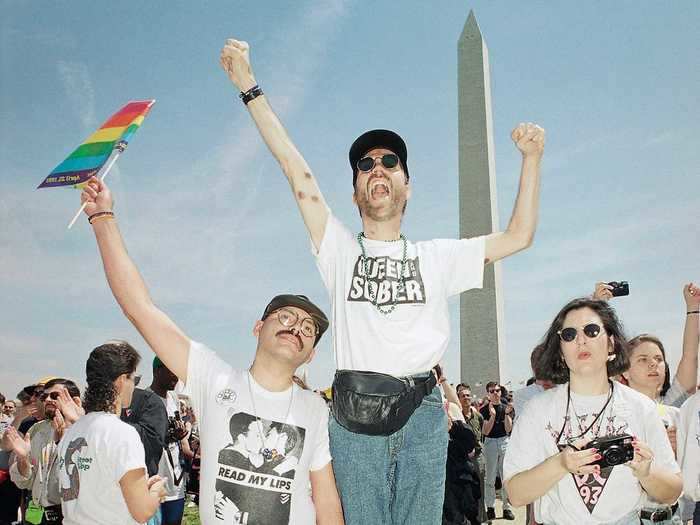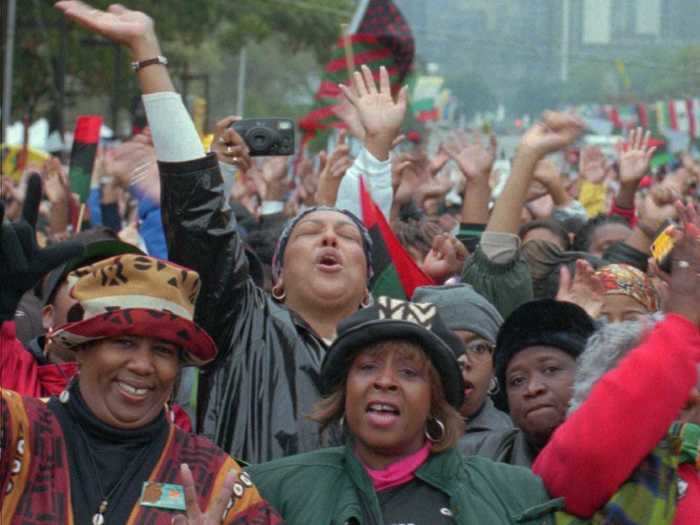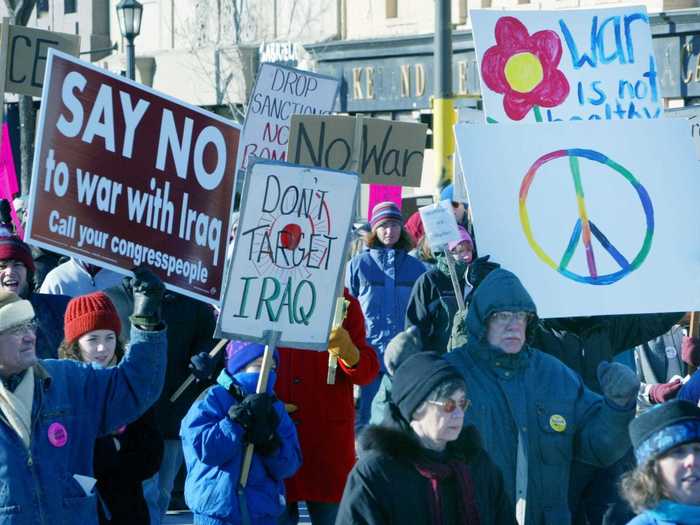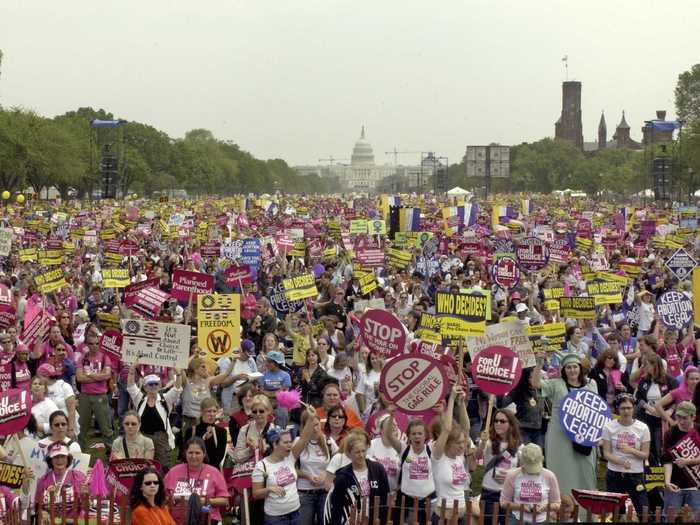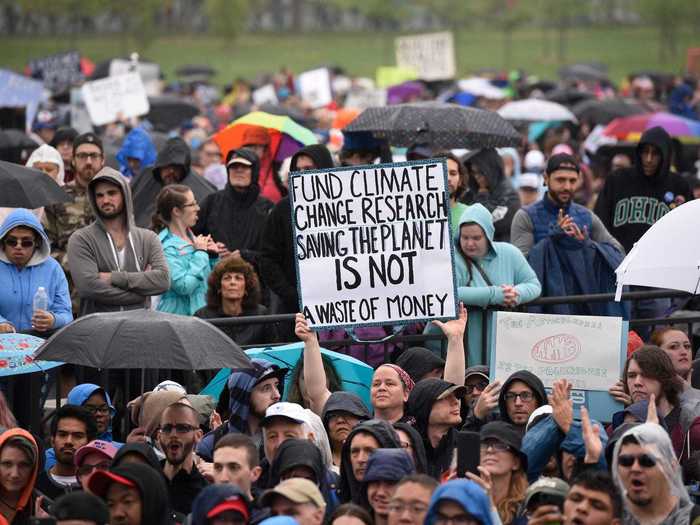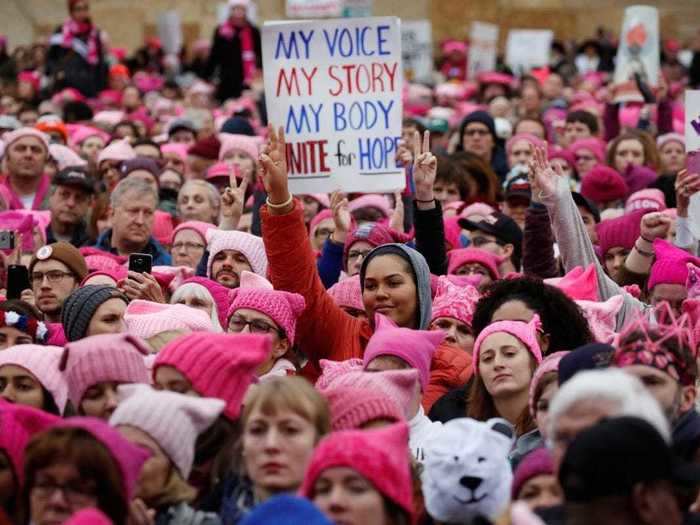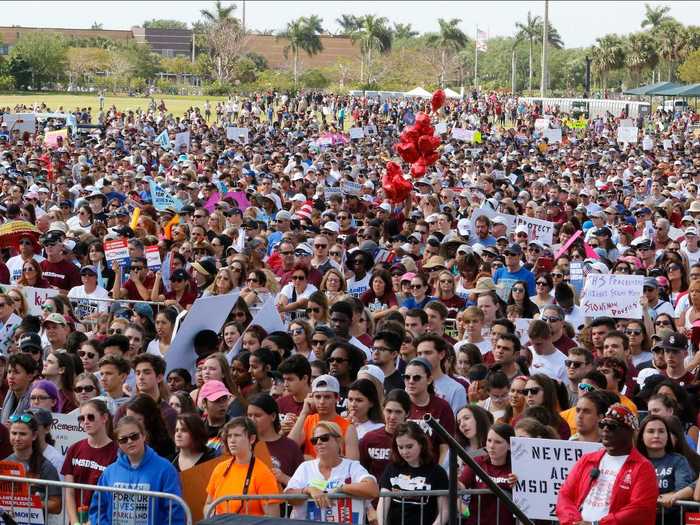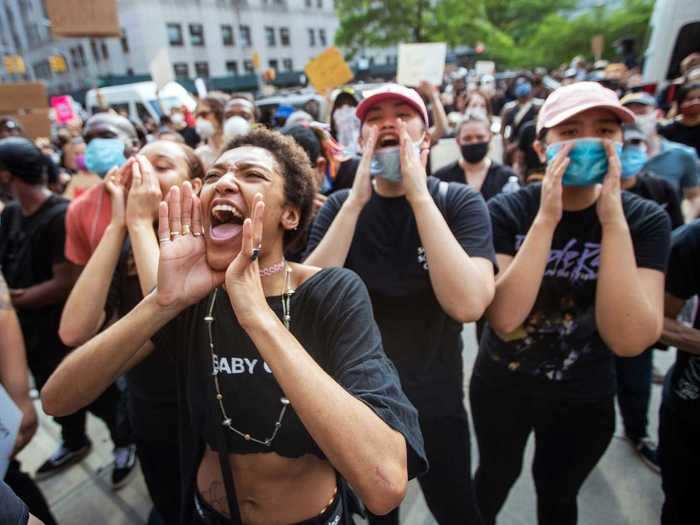Protesters rally after the death of George Floyd.Terray Sylvester/Reuters
- Millions of people in US history have protested and marched against injustices in an effort to enact social change.
- One of the most famous protests in US history was the March on Washington for Jobs and Freedom in 1963, where Martin Luther King Jr. delivered his "I Have a Dream" speech.
- The Women's March in 2017 was the largest march in US history, attracting between 3.2 and 5.2 million people.
- Over the past week, protests sparked by the death of George Floyd have seen tens of thousands march against systemic racism and the killing of black people in America.
Americans across the country are publicly expressing outrage at police brutality and the killings of George Floyd, Ahmaud Arbery, Breonna Taylor, and others.
Protests have occured through US history as a way for Americans to express outrage against hate, inequality, and violence and to enact change. The March on Washington for Jobs and Freedom in 1963 successfully pressured the Kennedy administration to pass civil rights bills.
The Women's March in 2017 was the largest single-day demonstration in US history, attracting up to 5.2 million protesters.
Here's a look back at some of the biggest marches in American history.
Read the original article on
Business Insider
The March on Washington for Jobs and Freedom was to protest the systemic disenfranchisement of black Americans and happened on August 28, 1963.
Martin Luther King Jr at the March on Washington for Jobs and Freedom.
AP
Approximately 250,000 people participated in the 1963 civil rights march in Washington, DC, where Martin Luther King, Jr. delivered his famous "I Have a Dream" speech.
After the march, King and other civil rights leaders met with President Kennedy and Vice President Lyndon B. Johnson at the White House, where they discussed the need for a strong civil rights bill. The Civil Rights Act of 1964 and Voting Rights Act of 1965 were enacted after the march.
An anti-Vietnam War protest in Washington, DC, happened on November 15, 1969.
Anti-Vietnam War protest.
AP
Between 500,000 and 600,000 people demonstrated against the Vietnam War, which had led to thousands of deaths by 1969. Coalitions started organizing smaller rallies in 1967, eventually leading up to the large anti-Vietnam march two years later.
The Solidarity Day march in Washington, DC, was on September 19, 1981. Thousands protested President Reagan's budget cuts and tax policies.
Solidarity Day March 1981.
AP
The Solidarity Day march was a rally of about 260,000 people in DC in 1981. It was sparked by President Ronald Reagan's decision to fire 12,000 air traffic controllers who went on strike and demanded wage increases and safer working conditions.
The Anti-Nuclear March in New York City's Central Park was on June 12, 1982. Protesters sought nuclear disarmament by the US government.
Anti-Nuclear March in New York.
Getty Images
In 1982, around a million protesters filled Central Park to protest nuclear weapons during Ronald Reagan's presidency.
A New York Times article from 1982 said, "The vast parade and rally, organized by a coalition of peace groups, brought together pacifists and anarchists, children and Buddhist monks, Roman Catholic bishops and Communist Party leaders, university students and union members."
The Million Man March was to promote unity and family values in black communities and happened in Washington, DC, on October 16, 1995.
Million Man March.
AP
In 1995, Washington, DC's Million Man March took place with a stated aim to unite the black community. Estimates for the number of attendees vary from 400,000 to 1.1 million people.
Notable speakers at the march included Jesse Jackson, Rosa Parks, Cornel West, and Maya Angelou.
The March on Washington for Lesbian, Gay, and Bi Equal Rights and Liberation was on April 25, 1993.
LGBT March on Washington, DC in 1993.
AP
Between 800,000 and a million people marched on the National Mall in 1993 for LGBTQ rights. The organizers' primary demands were civil rights bills against discrimination, an increase in AIDS research funding, and reproductive rights.
The Million Woman March in Philadelphia, Pennsylvania, was on October 25, 1997. Its aim was for unity in black communities and among black women.
Million Woman March.
AP
In 1997, two years after the Million Man March, anywhere from 500,000 to 2 million people convened for the Million Woman March. The event, which was held on a rainy Saturday in 1997, included prayer, musical performances, and speeches by local organizers and civil rights activists.
Protests against the Iraq war in America's largest cities occurred on February 15, 2003.
Iraq War protest.
Duane Braley/Star Tribune via Getty Images
As a protest to George W. Bush's decision to invade Iraq, between 10 to 15 million people marched in 600 cities across the world in 2003. At least 500,000 people protested in American cities, including New York City, Los Angeles, and Seattle.
It's known as the biggest protest in world history.
The March for Women's Lives was in Washington, DC, on April 25, 2004. Protesters advocated for reproductive rights, women's rights, and more.
March for Women’s Lives.
Reuters
In 2004, the March for Women's Lives was one of the largest protests in American history, with between 500,000 and 1.1 million attendees.
Notable attendees included women's rights activists Gloria Steinem, Dolores Huerta, former National Organization for Women presidents Eleanor Smeal and Patricia Ireland, and former Secretary of State Madeline Albright.
The People's Climate March occurred in New York City on September 21, 2014.
Demonstrators make their way down Sixth Avenue during the People's Climate March.
AP Photo/Jason DeCrow
The People's Climate March attracted between 311,000 and 400,000 participants. It is regarded as the biggest call-to-action on climate change.
Though the largest demonstration was in New York City, there were nearly 2,700 climate-related demonstrations in more than 150 countries.
The March for Science was held in the United States April 22, 2017. Protests advocated for environmental protection and sustainability.
March for Science protesters.
Sait Serkan Gurbuz/AP
The March for Science was held on Earth Day and attracted more than a million protesters around the world.
Participants advocated for a global focus on the International Panel on Climate Change's report on the catastrophic effects of a 1.5 degree Celsius increase in global temperature. Many also protested the Trump administration's budget cuts to the Environmental Protection Agency.
The largest Women's Marches occurred on January 21, 2017, and January 20, 2018. They called for women's autonomy over their own bodies.
A crowd at the Women's March on Washington, DC on January 21, 2017.
Shannon Stapleton/Reuters
The 2017 Women's March is considered the largest single-day protest in US history, attracting anywhere from 3,267,134 and 5,246,670 people, according to data compiled by The Washington Post. The 2018 Women's March attracted between 1.6 million and 2.5 million.
However, even for its gargantuan size, the Women's March has been criticized as having accomplished little more than visibility.
The March for Our Lives was a student-led protest for stricter gun control laws occurring across the United States on March 24, 2018.
March For Our Lives participants in Parkland, Florida.
Associated Press/Joe Skipper
The protest attracted between 1.2 and 2 million people. It occured a month after the Marjory Stoneman Douglas High School shooting, which many referred to as a turning point for gun control legislation.
The March for Our Lives mission is "to harness the power of young people across the country to fight for sensible gun violence prevention policies that save lives."
Protests in response to George Floyd's death began in Minneapolis on May 26, 2020, and remain ongoing in dozens of cities across the US.
Protesters demonstrate against the the death of George Floyd in New York.
AP Photo/Mary Altaffer
Tens of thousands of people have protested against police brutality and the systemic racism that contributed to the deaths of George Floyd, Ahmaud Arbery, Breonna Taylor, and many others.
The protests have been some of the most intense in US history. As Business Insider's Insider Today explained, "Floyd's murder was a tragic horror. The fact that it was captured on video compelled all Americans to face that horror directly. Black Americans saw themselves or their loved ones in that video. In that and other videos, many white Americans finally saw the racism, brutality, unfairness, and fear black Americans have had to live with forever."

